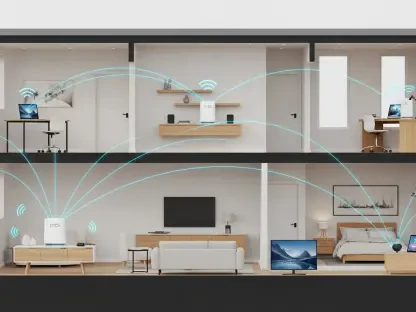In today’s fast-paced digital landscape, where businesses juggle data-intensive applications and sprawling global operations, network failures can cost millions in downtime, and a recent study revealed that 98% of enterprises experience significant disruptions due to outdated networking systems. This critical need for innovation sets the stage for a groundbreaking collaboration between Lumen Technologies and Meter, two companies redefining how enterprises connect through a seamless Network-as-a-Service (NaaS) model. Their partnership promises to turn complex, costly networking into a streamlined, utility-like experience, sparking curiosity about what this means for businesses worldwide.
The significance of this alliance lies in its potential to overhaul an industry burdened by inefficiency. As enterprises increasingly adopt AI-driven tools and cloud-based operations, the demand for agile, scalable networks has surged. Lumen, a telecom powerhouse, and Meter, a dynamic startup, are joining forces to address these needs with a unified solution that integrates wide area networks (WAN) and local area networks (LAN). This story uncovers how their combined expertise could set a new standard for connectivity, offering businesses a way to stay ahead in a hyper-connected era.
The Urgent Need for a Networking Overhaul
Enterprise networking has long been a labyrinth of high costs, fragmented systems, and relentless maintenance. Traditional setups often require massive upfront investments in hardware, leaving companies struggling to adapt when digital demands spike. With data traffic expected to grow by 25% annually through 2027, the strain on outdated infrastructure is undeniable, pushing businesses to seek alternatives that prioritize flexibility over ownership.
This growing frustration has exposed a gap in the market for solutions that simplify connectivity without sacrificing performance. Many organizations find themselves tethered to rigid systems that can’t keep pace with modern requirements like real-time analytics or remote workforces. The pressure to modernize is no longer optional but a necessity for survival in competitive industries such as retail and healthcare, where downtime directly impacts customer trust.
Why NaaS Is the Game-Changer Enterprises Crave
Network-as-a-Service (NaaS) emerges as a beacon of hope in this cluttered landscape, offering a subscription-based approach akin to cloud computing. By shifting the burden of infrastructure management to providers, NaaS allows businesses to scale networks on demand, slashing capital expenditures. This model is gaining traction, with adoption rates climbing as companies recognize the value of paying for connectivity as a utility rather than a fixed asset.
Lumen and Meter stand at the forefront of this shift, leveraging NaaS to tackle real pain points. Their combined offering streamlines both WAN and LAN services, ensuring enterprises no longer juggle multiple vendors or disjointed platforms. This integration is particularly vital for industries adopting AI at scale, where consistent, high-speed connectivity forms the backbone of innovation and operational efficiency.
Inside the Lumen-Meter Collaboration
At the heart of this transformative partnership is a shared vision to simplify enterprise networking through a single, cohesive product. Lumen brings its extensive WAN expertise, already serving over 1,000 customers on its NaaS platform, while Meter contributes cutting-edge LAN solutions. Together, they enable businesses to procure and manage connectivity via intuitive tools like the Meter Connect portal, breaking down operational silos that have long plagued the sector.
A standout feature of their joint effort is a focus on AI-ready solutions, ensuring networks can handle the data-heavy demands of modern applications. Meter’s innovative approach further differentiates the partnership by absorbing upfront costs and even buying back existing hardware to offset expenses—a bold move that challenges traditional vendors. Serving diverse clients from healthcare providers to retail giants like Liberty Tax, their impact is already evident across multiple sectors.
Their collaboration is fueled by substantial financial backing, with Meter securing $170 million in a recent Series C round, bringing total funding to $250 million. This investment underscores market confidence in their mission to redefine connectivity. From integrated dashboards to tailored solutions, the partnership delivers practical tools that empower enterprises to focus on growth rather than infrastructure headaches.
Leadership Insights Driving the Vision
Voices from the top of both companies shed light on the urgency and ambition behind this alliance. Lumen CEO Kate Johnson has stressed the importance of preparing for AI’s explosive growth, noting, “Businesses need networks that match the speed of AI innovation, and that’s the foundation we’re building.” Her perspective underscores a commitment to future-proofing connectivity for data-intensive environments.
Meter’s co-founder and CEO Anil Varanasi offers a complementary view, emphasizing accessibility and control. “We’re creating the AWS of networking—customers deserve full transparency, not a locked system,” he stated. This philosophy is reflected in Meter’s latest unveilings at the MeterUp event, including Wi-Fi 7 access points and plans for fully autonomous networks by 2027, signaling a relentless push toward automation and user empowerment.
These insights reveal a dual focus on innovation and practicality, blending Lumen’s established scale with Meter’s disruptive energy. Their combined leadership paints a picture of networking as a seamless utility, poised to evolve alongside the digital ambitions of enterprises globally, setting a benchmark for what connectivity can achieve.
Actionable Steps for Businesses to Adapt
For enterprises eager to capitalize on this wave of change, the Lumen-Meter partnership offers tangible benefits and a clear path forward. Start by evaluating current network setups to pinpoint limitations in scalability or compatibility with emerging technologies like AI. Identifying these gaps is crucial to understanding where modern solutions can drive the most impact without overhauling entire systems overnight.
Consider transitioning to a NaaS model to minimize upfront costs and enhance flexibility, using platforms like the Meter Dashboard for streamlined oversight of performance metrics. This approach not only reduces financial strain but also aligns with a broader trend toward subscription-based services that adapt to fluctuating needs. Transparency should also be a priority—opt for providers that grant full control over network operations rather than opaque, vendor-driven systems.
Looking ahead, align with partners investing in automation and AI-driven connectivity to safeguard infrastructure against future demands. Planning for long-term resilience ensures businesses remain competitive as digital landscapes evolve. Engaging with solutions that integrate WAN and LAN under one umbrella can simplify this journey, positioning companies to thrive in an increasingly connected world.
Reflecting on a Milestone in Connectivity
Looking back, the partnership between Lumen Technologies and Meter stood as a pivotal moment that reshaped enterprise networking through an innovative NaaS framework. Their integration of WAN and LAN services tackled longstanding inefficiencies, delivering a blueprint for simplicity and scalability that many had sought for years. This collaboration not only addressed immediate challenges but also laid the groundwork for smarter, AI-ready systems.
As businesses navigated the aftermath of this shift, the next steps involved actively exploring subscription-based models to reduce operational burdens. Evaluating partnerships with providers committed to transparency and automation became essential for staying ahead. Moreover, investing in tools that offered unified management emerged as a practical way to streamline connectivity, ensuring enterprises could focus on innovation rather than infrastructure. This era marked a turning point, urging companies to rethink networking as a dynamic enabler of growth.









